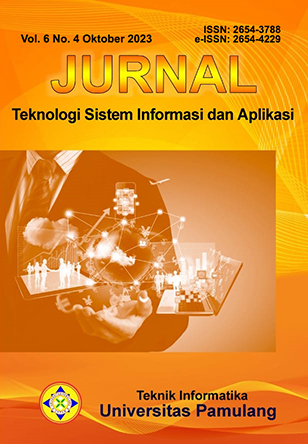Rancang Bangun Sistem Informasi Akuntansi Penggajian Karyawan dengan Menerapkan Metode Waterfall
Kata Kunci:
Information Systems, Employee, Payroll, Microsoft Visual Studio, WaterfallAbstrak
Based on research conducted that the Center for Standardization and Services of the Cellulose Industry has fully used a computerized system, namely the Central Civil Servant Salary Application (GPP). However, there are obstacles related to the system where there are often system updates that take a lot of time, thus hampering the salary calculation process. Referring to these problems, this study focuses on improving the employee payroll system that is more optimal and the system is able to provide convenience in controlling employee perfomance activites using the waterfall method. The waterfall method includes 5 stages including system requirements analysis, design, program code generation, testing and support or maintance. The waterfall methors has a sequential process and has a clear and detailed flow, so that unmet system needs will be analyzed indepth to be developed into a system that is in accordance with what is expected and on target. So the final result by applying the waterfall method to the system design made is the processing of employee payroll data more quickly and effectively and helps those who need information as quickly as possible.
Referensi
Akbar, M. F. (2023). Penerapan Metode Waterfall pada Sistem Informasi Penjualan dan Persediaan Pada Warung Makan Hejo Karawang. Indonesian Journal Computer Science, 2(1), 29-34. https://doi.org/10.31294/ijcs.v2i1.1902.
Amir, A. Y., & Devi, P. A. R. (2022). Sistem Informasi Penggajian Karyawan Berbasis Framework Codeigniter di Toko Citra Mandiri Gresik. Jurnal FASILKOM, 12(1), 35-42. https://doi.org/10.37859/jf.v12i1.3472.
Andriana, M., & Ulfa, Y. S. W. (2022). Sistem Informasi Penggajian Karywan Berbasis Web. Jurnal JUTITI, 2(2), 85-93. https://doi.org/10.55606/jutiti.v2i2.373.
Gaffar, G., & Gaffar, M. I. (2023). Analisis Sistem Informasi Akuntansi Penggajian Pegawai Negeri Sipil Pada Universitas Negeri Gorontalo. Jambura Accounting Review, 4(1), 159-173. https://jar.fe.ung.ac.id/index.php/jar/article/view/73.
Gusmiran, M. R., Halimatussadia’ah., & Heriyati. (2023). Aplikasi Penggajian Pada Cinepolis Kalibata City Menggunakan Java Netbeans. Semnas (Seminar Nasional Riset dan inovasi Teknologi), 7(1), 323-329. https://doi.org/10.30998/semnasristek.v7i1.6291.
Gustiwan, A., & Tristianto, C. (2022). Perancangan Sistem Informasi Penggajian Karyawan Berbasis Web Menggunakan Metode Extreme Programming pada PT. Pradana Energi Gemilang. Jurnal Ilmu Komputer. 5(1), 1-6. https://jurnal.pranataindonesia.ac.id/index.php/jik/article/view/110/63.
Kamil, A., Hasdiana., & Lubis, H. (2023). Rancang Bangun Sistem Informasi Penggajian Berdasarkan Absensi Kehadiran Pada Kantor Azhar Maksum dan Rekan. Jurnal Ilmu Komputer dan Informatika, 7(1), 1-14. http://dx.doi.org/10.30829/algoritma.v7i1.15262.
Kementerian Keuangan Republik Indonesia. (2022). Nomor 178/OMK.05/2022 Pasal 1 tentang Tata Cara Penerbitan dan Pengesahan Surat Keterangan Penghentian Pembayaran Secara Elektronik. https://peraturan.bpk.go.id/Home/Details/232901/pmk-no-178pmk052022.
Murdiani, D., & Hermawan, H. (2022). Perbandingan Metode Waterfall dan RAD (Rapid Application Development) pada Pengembangan Sistem Informasi. Jurnal Teknologi Informasi (JurTi), 6(1), 14-23. https://doi.org/10.36294/jurti.v6i1.2544.
Murdiani, D., & Sobirin, M. (2022). Perbandingan Metodologi Waterfall dan RAD (Rapid Application Development) dalam Pengembangan Sistem Informasi. Jurnal teknologi Informatika (JUTEKIN), 10(2), 95-104. https://dx. doi.org/10.51530/jutekin.v10i2.655.
Muslihudin, M., & Oktafianto. (2016). Analisis dan Perancangan Sistem Informasi Akuntansi Menggunakan Model Terstruktur dan UML. Yogyakarta. CV. Andi Offset (Penerbit ANDI).
Muslihudin, M., Fauzi., Abadi, S., Trisnawati., & Mukodimah, S. (2021). Implementasi Konsep Decision Support System dan Fuzzy Multiple Attribute Decision Making (FMADM) (cetakan pertama, maret 2021). Indramayu. Penerbit Adab (CV. Adanu Abimata).
Putra, S. H., & Taufiq, F. P. (2020). Perancangan Aplikasi Penggajian Karyawan pada CV. Contect Jaya Berbasis Web dengan Metode Waterfall. Jurnal Minfo Polgan (Jurnal Manajemen Informatika, 9(2), 18-27. https://doi.org/10.33395/jmp.v9i2.10950.
Rivantunisa, C. (2022). Sistem informasi Penggajian Pegawai pada Dinas Tenaga Kerja Kota Bandung. Jurnal Informatika dan Komputer (INFOKOM), 10(1), 22-33. http://journal.piksi.ac.id/index.php/INFOKOM.
Sadiah, J., Indaryono., & Yusuf, A. M. (2021). Sistem Informasi Akuntansi Penggajian Berbasis VB. Net Pada PT. Bank Perkreditan Rakyat (BPR) Sanggabuana Agung Karawang. Jurnal Interkom : Jurnal Publikasi Ilmiah Bidang Teknologi Informasi dan Komunikasi, 15(4), 190-200. https://doi.org/10.35969/interkom.v15i4.80.
Sukamto, R. A., & Shalahuddin, M. (2018). Rekayasa Perangkat Lunak Terstruktur dan Berorientasi Objek (cetakan pertama edisi revisi, april 2018). Bandung. Informatika.
Unduhan
Diterbitkan
Cara Mengutip
Terbitan
Bagian
Lisensi
Hak Cipta (c) 2023 Megaranti Salsabila, Ratnanto Aditiarno, Candra Mecca Sufyana

Artikel ini berlisensi Creative Commons Attribution-NonCommercial 4.0 International License.
Authors who publish with this journal agree to the following terms:
- Authors retain copyright and grant the journal right of first publication with the work simultaneously licensed under a Creative Commons Attribution License that allows others to share the work with an acknowledgement of the work's authorship and initial publication in this journal.
- Authors are able to enter into separate, additional contractual arrangements for the non-exclusive distribution of the journal's published version of the work (e.g., post it to an institutional repository or publish it in a book), with an acknowledgement of its initial publication in this journal.
- Authors are permitted and encouraged to post their work online (e.g., in institutional repositories or on their website) prior to and during the submission process, as it can lead to productive exchanges, as well as earlier and greater citation of published work (See The Effect of Open Access).
Jurnal Teknologi Sistem Informasi dan Aplikasi have CC BY-NC or an equivalent license as the optimal license for the publication, distribution, use, and reuse of scholarly work.
In developing strategy and setting priorities, Jurnal Teknologi Sistem Informasi dan Aplikasi recognize that free access is better than priced access, libre access is better than free access, and libre under CC BY-NC or the equivalent is better than libre under more restrictive open licenses. We should achieve what we can when we can. We should not delay achieving free in order to achieve libre, and we should not stop with free when we can achieve libre.
This work is licensed under a Creative Commons Attribution-NonCommercial 4.0 International (CC BY-NC 4.0) License
YOU ARE FREE TO:
- Share - copy and redistribute the material in any medium or format
- Adapt - remix, transform, and build upon the material for any purpose, even commercially.
- The licensor cannot revoke these freedoms as long as you follow the license terms



_2020_-_7(2)_2024_-_Thumbnail.png)












